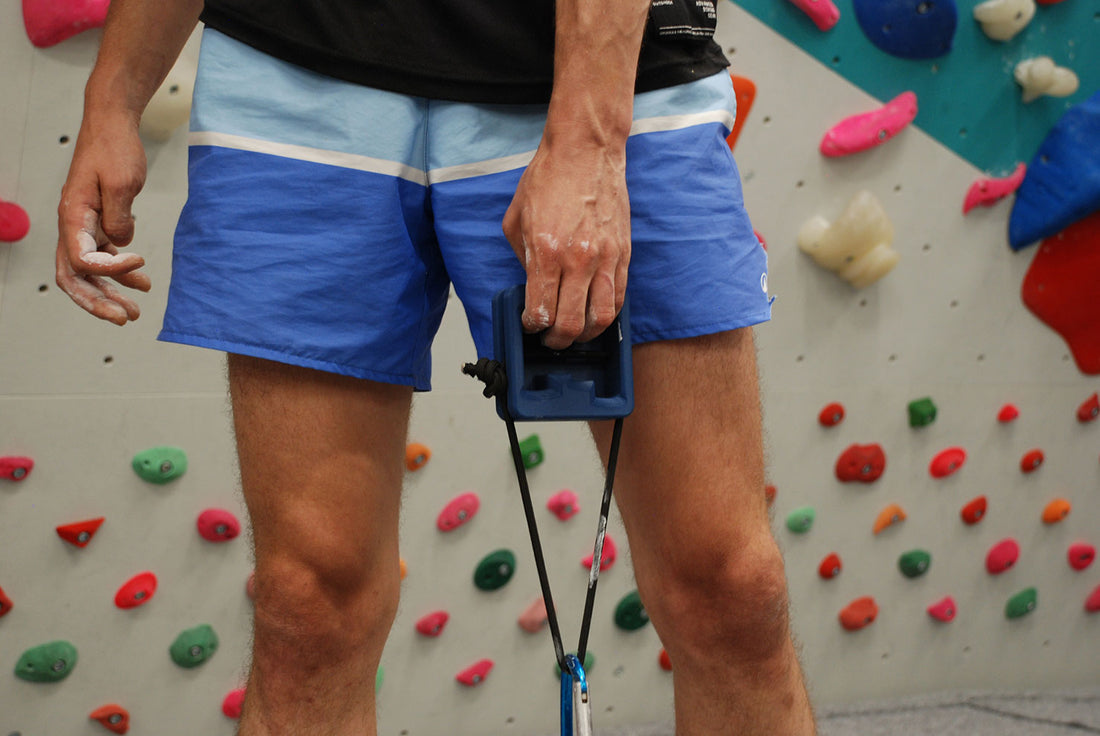If you’ve been searching for rock climbing lessons, you’re ready to embark on an exciting journey from your first climb to becoming a confident climber. Whether you want to develop core skills in lead climbing, refine your technique for bouldering, or gain hands-on experience climbing on real rock outdoors, structured climbing courses provide the perfect combination of expert instruction, essential safety knowledge, and practical training.
These lessons are carefully designed to guide you step-by-step through the learning process. You’ll start by mastering the basics, such as using climbing equipment and practicing climbing wall techniques indoors. As you progress, you’ll move on to more advanced challenges, including outdoor climbing and even mountaineering.
With the support of the right instructor, tailored training, and high-quality equipment, you can advance confidently at your own pace. Whether you're a complete beginner or striving to reach a higher level of competence in sport climbing or lead climbing, these lessons will help you achieve your goals.
Who Rock Climbing Lessons Are For
Rock climbing lessons cater to a diverse audience. Whether you're an absolute beginner stepping onto the wall for the first time, a returning climber refreshing your skills, a parent introducing your kids to climbing, or an intermediate climber looking to overcome a plateau, there's something for everyone. The main prerequisites are straightforward: a basic level of fitness and a willingness to learn and engage with the climbing process.
These lessons provide structured guidance to help you build confidence and improve your skills, no matter where you’re starting from.
Beginners: First-Time Goals
If you’re new to climbing, your first lesson will focus on essential safety practices, mastering basic movement techniques, and understanding supervised belaying or bouldering etiquette. These sessions are designed to ease the natural fear of heights by introducing climbing in a supportive and controlled environment. By the end of your first lesson, you’ll have a clear understanding of the next steps to take and how to advance your climbing journey with confidence.
Intermediates: Break Plateaus
For intermediate climbers who feel stuck, lessons are tailored to refine your efficiency by improving footwork, pacing, route-reading, and applying expert redpoint tactics. Instructors can identify common habits that may be holding you back, such as overgripping or rushing your foot placements. They’ll provide personalized advice to help you climb smarter, not just harder.
These sessions are designed to push you beyond your plateau and elevate your climbing to the next level.
Kids & Families
Climbing lessons for kids and families are designed to be fun, engaging, and safe. They incorporate games-based drills to cater to shorter attention spans, with clear rules and close supervision. Safety is a top priority, with harnesses and helmets sized specifically for children to ensure both comfort and security. These sessions foster a love of climbing from a young age while teaching age-appropriate skills in a playful and supportive environment.
Core skills you’ll learn
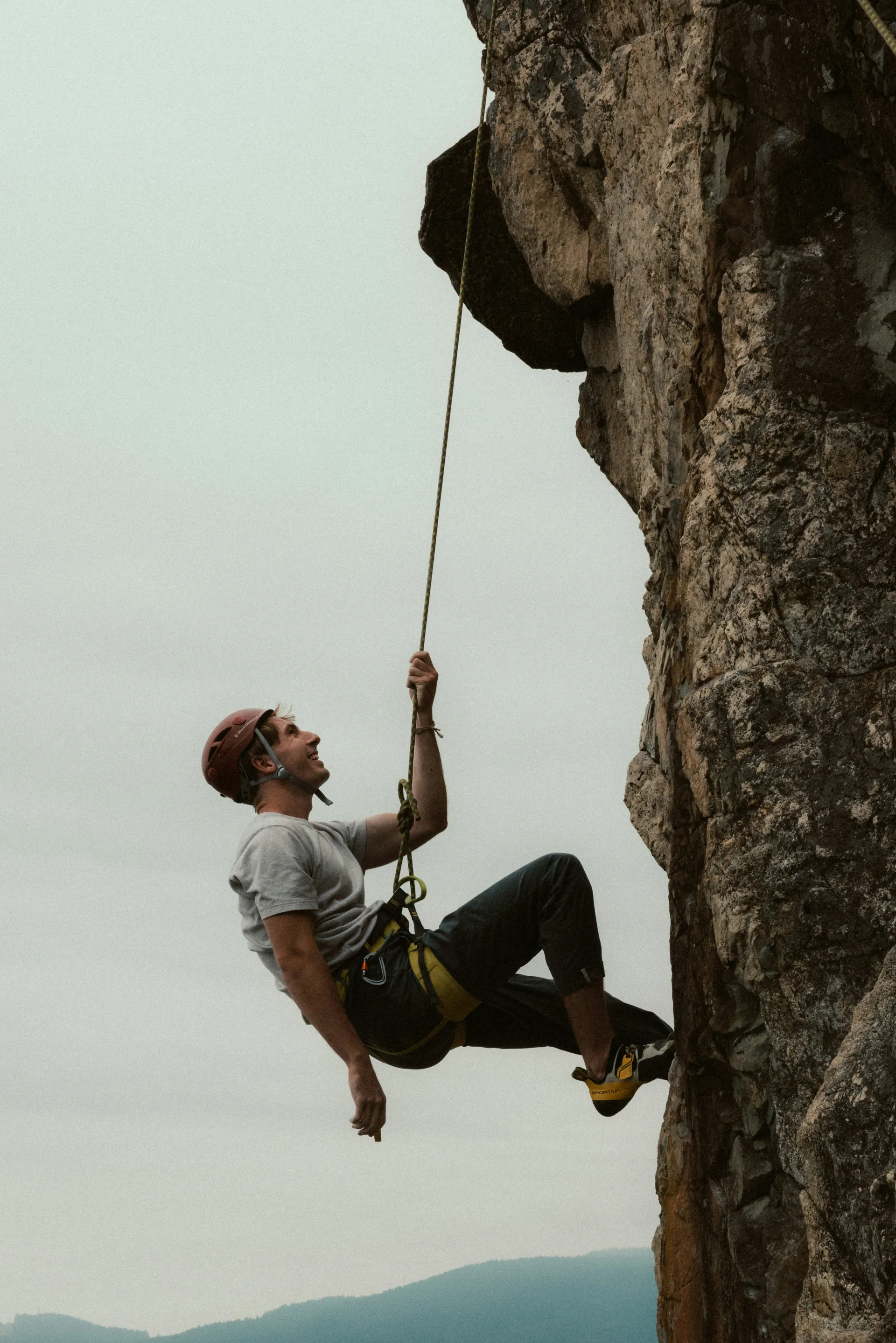
When you join climbing courses, you’ll focus on several core pillars that form the foundation of safe and efficient climbing. These lessons break down skills into concrete, testable steps so you can track your progress and build confidence.
Expect to get hands-on with safety practices, essential knots, movement techniques, and controlled falling exercises—all designed to develop your climbing ability methodically.
Safety & risk management
Understanding the safety flow is critical from day one. You’ll learn gym rules, effective partner checks, standard climbing commands, and how to identify fall zones. On bouldering walls, spotting techniques will be taught to help protect climbers during falls.
This knowledge fosters a culture of care and ensures everyone climbs responsibly.
Belaying & essential knots (top-rope first)
Mastering belay device handling and the discipline of keeping your brake hand engaged are cornerstones of safe climbing. You’ll become proficient tying in with the figure-eight follow-through knot and conducting thorough partner safety checks. Starting with top-rope belaying, these skills are essential to protect yourself and your climbing partners.
Movement fundamentals
Good climbing depends on efficient technique. Lessons cover balance, placing quiet feet precisely, optimal hip positioning, and using straight-arm rests to conserve energy.
You’ll also practice route sequencing and drills to develop a natural sense of weight transfer, allowing you to climb smoothly rather than relying solely on strength.
Falling practice (progressive, bouldering first)
Fear of falling can hold many climbers back. Through progressive exercises starting with controlled step-offs and small falls onto padded surfaces, you’ll learn proper landing and catching techniques. Practicing falls in a controlled setting helps reduce anxiety and builds trust in your equipment and skills, preparing you for the challenges of climbing outdoors.
Indoor lessons (most people start here)
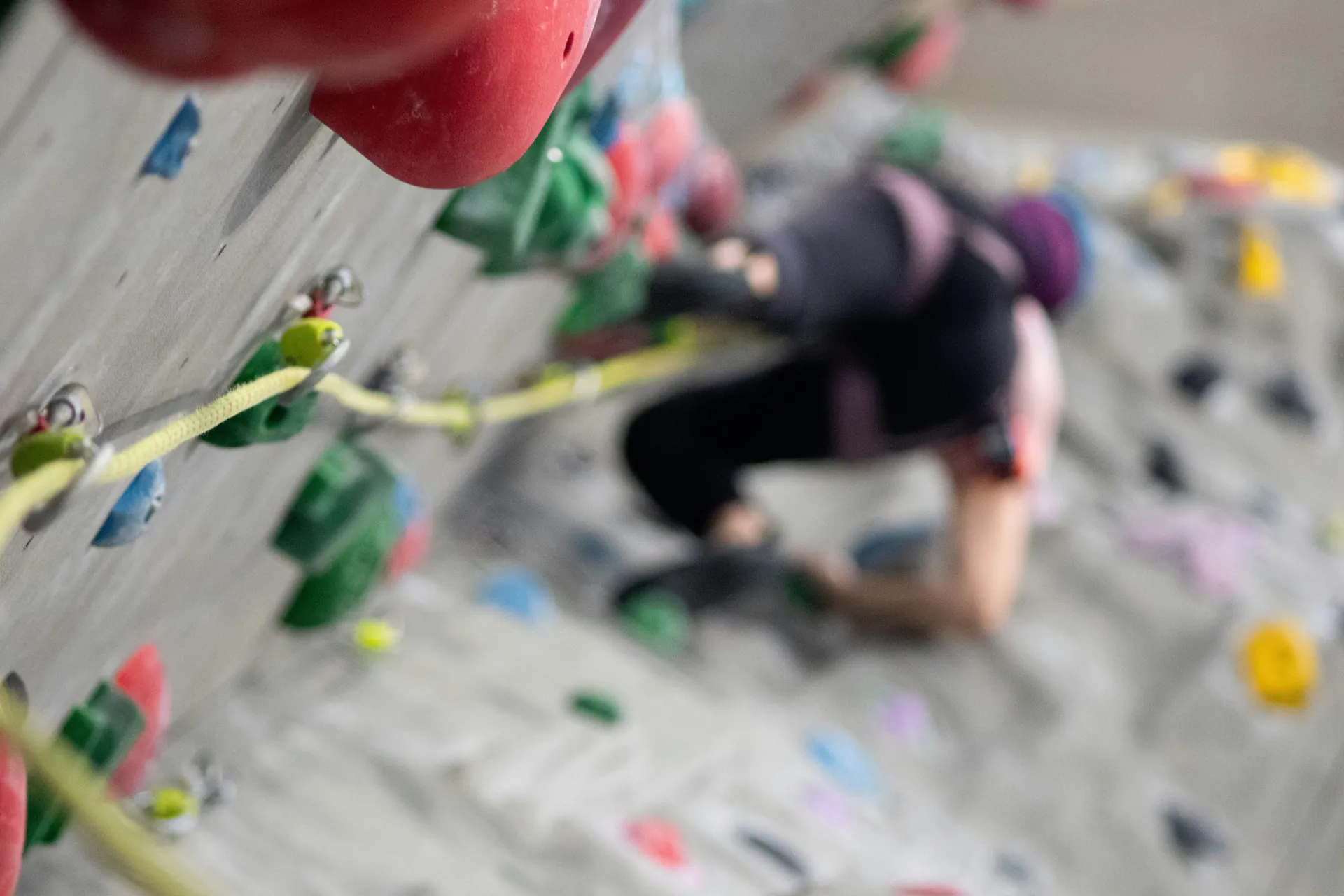
Indoor climbing lessons provide the ideal environment for newcomers to develop foundational skills in a controlled and supportive setting. Lesson formats often combine practical skill-building with safety training, allowing you to learn at your own pace under the watchful eye of an expert instructor.
These sessions usually culminate in a certification—such as a belay certification—which is essential for progressing safely whether you stay indoors or transition outdoors. Certification demonstrates your ability to manage rope systems responsibly and climb with confidence, making it a key milestone on your climbing journey.
Your first session step-by-step
Your first indoor lesson typically begins with a thorough warm-up to prepare your body for climbing. Next, you’ll get fitted with essential equipment like harnesses and climbing shoes.
After this, you’ll be introduced to basic knots and the fundamentals of belaying. Guided by your instructor, you’ll attempt easy climbs while receiving real-time coaching on technique and safety. The session wraps up with a debrief where you’ll review what you learned and receive homework to reinforce your skills before the next lesson.
Belay certification pathway
Achieving belay certification involves a clear progression: after initial practice sessions, you undergo a formal assessment where your knot-tying, device handling, and partner safety checks are evaluated. Once certified, you climb under supervision to build experience until your instructor signs you off for independent climbing. If necessary, retests ensure you meet the safety standards fully, guaranteeing that you’re prepared to climb responsibly.
Group vs. private lessons
Group lessons tend to be more affordable and offer a lively, social learning atmosphere, ideal for those who enjoy shared experiences and general introductions to climbing. However, they may offer less personalized attention due to class size. Private lessons provide tailored coaching focusing closely on your specific needs, making them perfect for climbers who want rapid progress or have specialized goals.
Private sessions offer flexible scheduling but usually at a higher cost. Choose the format that best fits your learning style, budget, and scheduling preferences.
Outdoor lessons (when you’re ready)
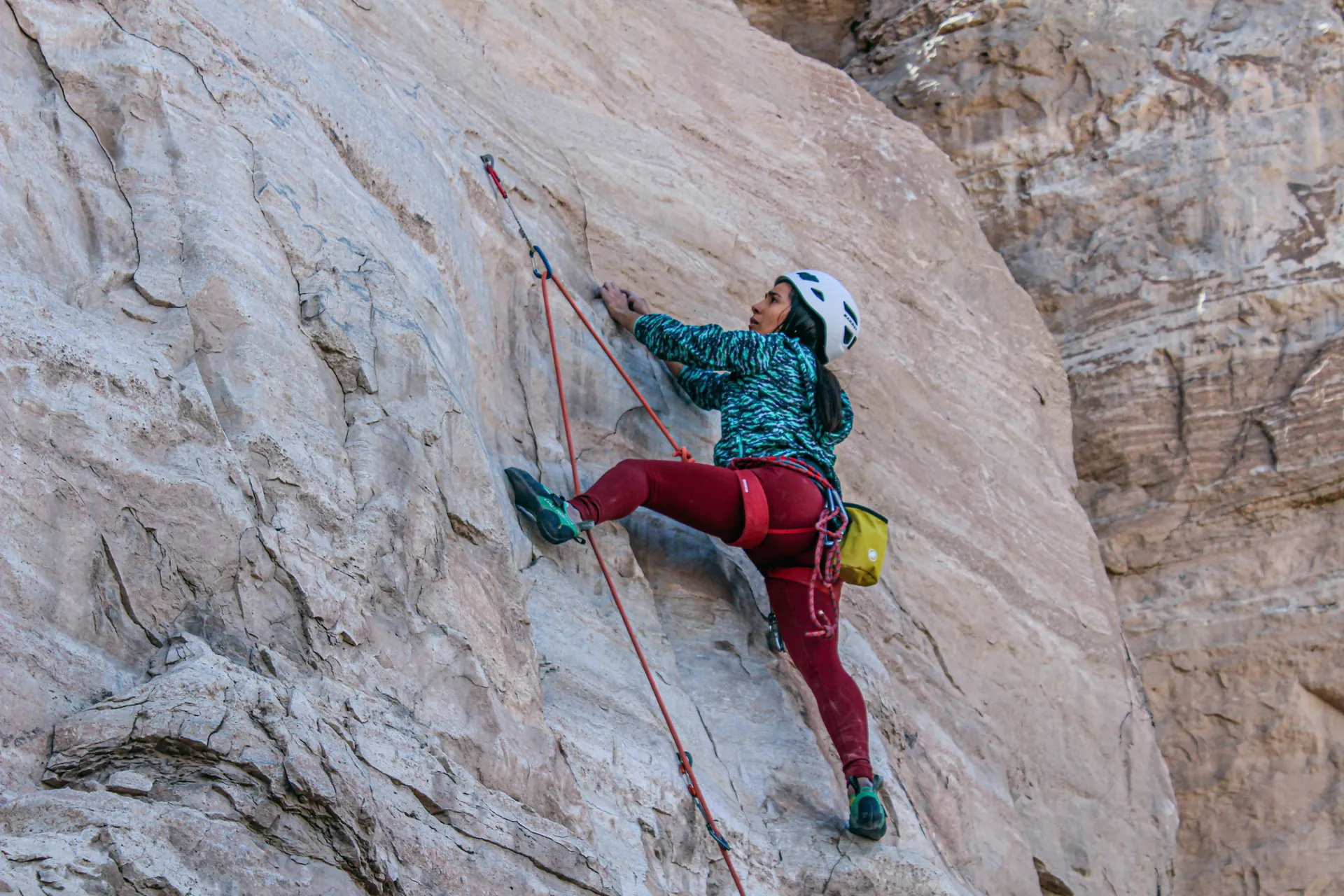
Once you’ve built a solid foundation indoors, outdoor lessons offer a new level of challenge and excitement by introducing you to the natural environment. Climbing outside requires adapting to varied terrain, unpredictable weather, and additional objective hazards such as loose rock or changing conditions.
In these lessons, you’ll also learn to manage extra equipment like natural anchors and protection systems. Expect a different rhythm and mindset, as outdoor climbing demands heightened awareness of the environment and a focus on safety considerations.
Top-rope skills outside
In outdoor settings, top-rope climbing isn’t just about your movement—it involves understanding site organization, recognizing anchor setups, and maintaining situational awareness. Your instructor will introduce you to anchor principles tailored to your skill level and emphasize effective communication, which is essential for overcoming challenges like wind or ambient noise. Managing the rope efficiently to prevent tangles or abrasion is another key focus during these lessons.
Sport lead progression (intro)
When you’re ready, you’ll dive into sport lead climbing, where you’ll learn how to clip quickdraws, manage a lead belay, and safely practice controlled falls. These skills build on your indoor lead experience and introduce new route strategies, including pacing and clipping techniques. This stage is critical for developing confidence in managing the rope while ascending and tackling the mental challenges of leading outdoors.
Trad/single-pitch awareness (intro only)
Traditional climbing introduces added complexities like placing your own gear and building anchors. Outdoor lessons at this level provide a conceptual overview of protection placement and anchor fundamentals to enhance your awareness. Because of its complexity and higher risks, pursuing these skills with qualified instructors is essential. They will ensure a focus on safety and sound decision-making throughout the process.
Choosing a program or instructor
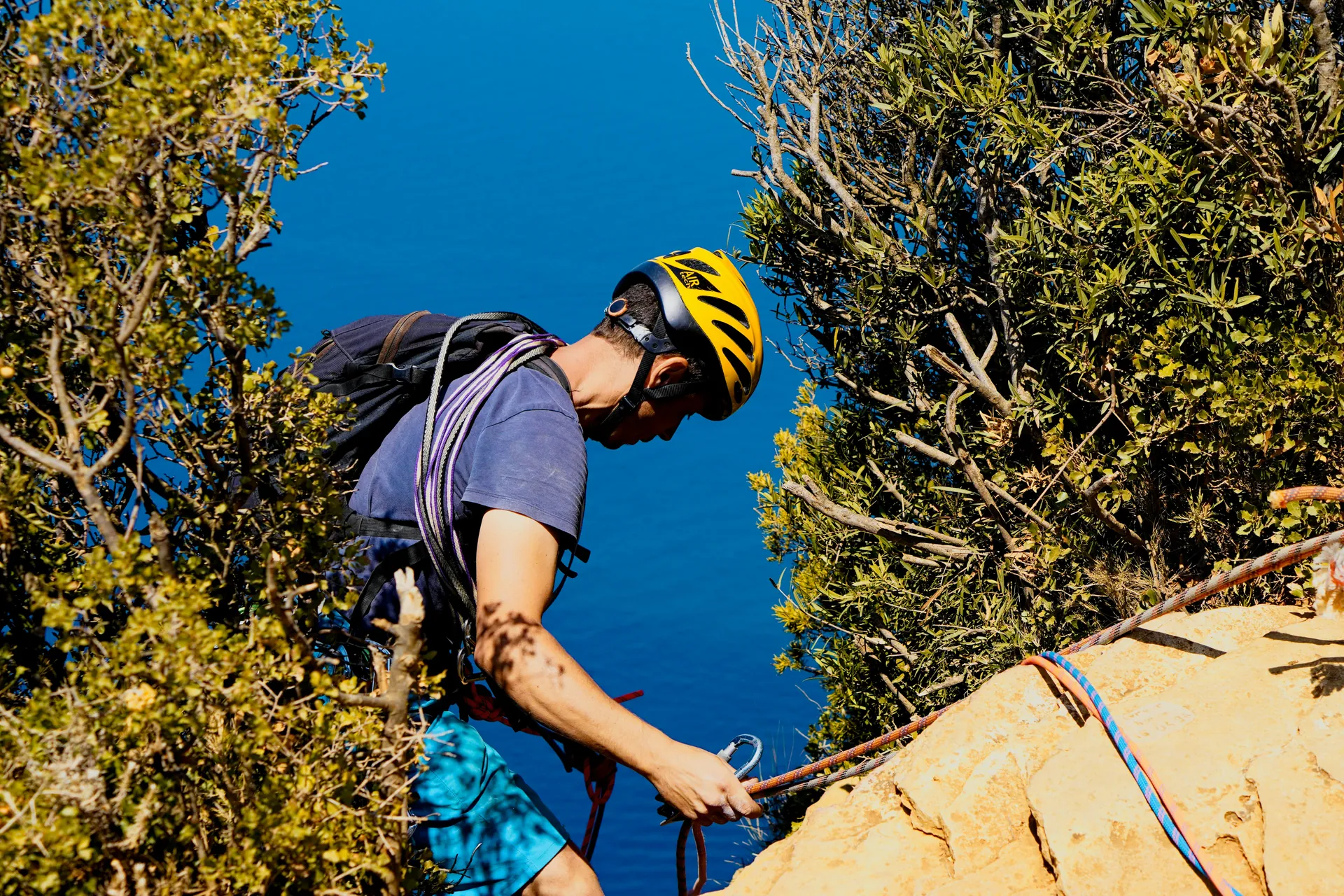
When selecting a climbing course or instructor, it’s essential to consider several factors that impact both your safety and the quality of your experience. Look for instructors with recognized certifications and extensive climbing experience to ensure you’re learning from trusted professionals.
Pay attention to student-to-instructor ratios. Smaller groups offer more personalized attention, additional climbing repetitions, and timely feedback. A clear syllabus or curriculum that outlines the skills you’ll be tested on, progression milestones, and what “independent climbing” means at that facility is essential for managing your expectations.
Additionally, confirm that the program is properly insured, and take the time to read reviews to understand others’ experiences and satisfaction levels.
Qualifications & ratios
Certified instructors create a safer and more effective learning environment. Programs led by instructors with credentials from reputable organizations like the American Mountain Guides Association (AMGA) or the Professional Climbing Instructors Association (PCIA) demonstrate adherence to rigorous standards.
Smaller student-to-instructor ratios mean you’ll benefit from more focused coaching time and ample practical climbing repetitions. This accelerates skill development and builds your confidence on the wall.
Curriculum & progression
Request a written course outline that details the skills you’ll learn and be tested on, key milestones throughout the program, and the level of independence you’re expected to achieve upon completion. Knowing these details helps you track your progress and ensures the course aligns with your personal climbing goals, whether you’re aiming to master beginner top-rope skills or advanced lead climbing techniques.
Equipment provided vs. bring your own
Most climbing courses supply essential equipment such as harnesses, climbing shoes, helmets, and belay devices. However, it’s important to confirm what’s included to avoid unexpected surprises.
Consider the hygiene and fit of provided gear, especially for shoes and helmets, as poorly fitting equipment can compromise both comfort and safety. Some programs may encourage or require you to bring your own equipment if you have it, which can be a more sanitary and convenient option.
Gear for Lessons (Essentials)
As you prepare for your climbing lessons, having the right gear is key to ensuring comfort, safety, and an enjoyable experience. For beginners, your essential kit typically includes comfortable climbing shoes, a properly fitting harness, a belay device with a locking carabiner (if you’ll be belaying), chalk to keep your hands dry, and water to stay hydrated. When climbing outdoors, add a helmet along with layers suitable for the weather, plus sun and bug protection to handle environmental conditions safely.
Shoes: Fit & Comfort
Your climbing shoes should fit snugly but never painfully tight. For beginner lessons, prioritize shoes that provide good sensitivity for edging and smearing over aggressively downturned models designed for advanced climbing. Comfortable shoes promote better technique and longer climbing sessions without unnecessary foot fatigue.
Harness & Belay Device
Ensure your harness fits well with secure waist and leg loops that are comfortably snug. Learn how to correctly tie into the tie-in points and familiarize yourself with your belay device, whether it’s a manual belay plate or an assisted-braking device.
Pay attention to the proper orientation of your locking carabiner, as correct setup is critical for safety during belaying.
Helmet (Especially Outdoors)
If your lessons take place outdoors, a helmet becomes an indispensable piece of gear. A well-fitting helmet sits low on your forehead and has a snug strap system to prevent movement during climbs or falls. Helmets protect you from potential impacts like falling rocks or gear and are essential when climbing natural rock.
Fitness Prep & Homework Between Lessons
To accelerate your progress between climbing lessons, incorporating short at-home drills targeting technique, conditioning, and mobility can be incredibly effective. These exercises not only reinforce what you learn during sessions but also enhance your overall climbing performance and reduce the risk of injury.
Technique Homework
Practice moving with silent feet on easy terrain to develop precise foot placement and minimize wasted energy. Implement the three-second rule—pause and stabilize for three seconds before moving your hands. This helps you maintain control and plan your next move with intention.
Additionally, incorporate planned breathing to stay calm and manage exertion, especially when tackling more challenging climbs. Controlled breathing can significantly improve your focus and endurance.
Simple Conditioning
Commit to 2–3 short weekly sessions targeting key climbing muscles. Exercises like pull-ups and rows will strengthen your upper body, while hollow body holds are excellent for building the core tension necessary to maintain proper body positioning on the wall. Don’t overlook your lower body—calf raises can boost foot stability and endurance, which are vital for longer climbs.
Mobility & Injury Prevention
Maintaining flexibility and preventing injuries are essential for long-term climbing success. Regularly work on wrist, forearm, and shoulder mobility to keep these critical areas supple and strong. Finger care is equally important—avoid overloading tendons by progressively building strength, and always stop immediately if you experience sharp pain or numbness.
Incorporate gentle stretching and mobility drills into your routine. These practices not only help prevent injuries but also ensure you can climb longer and stronger.
Sample lesson pathways (4–6 weeks)
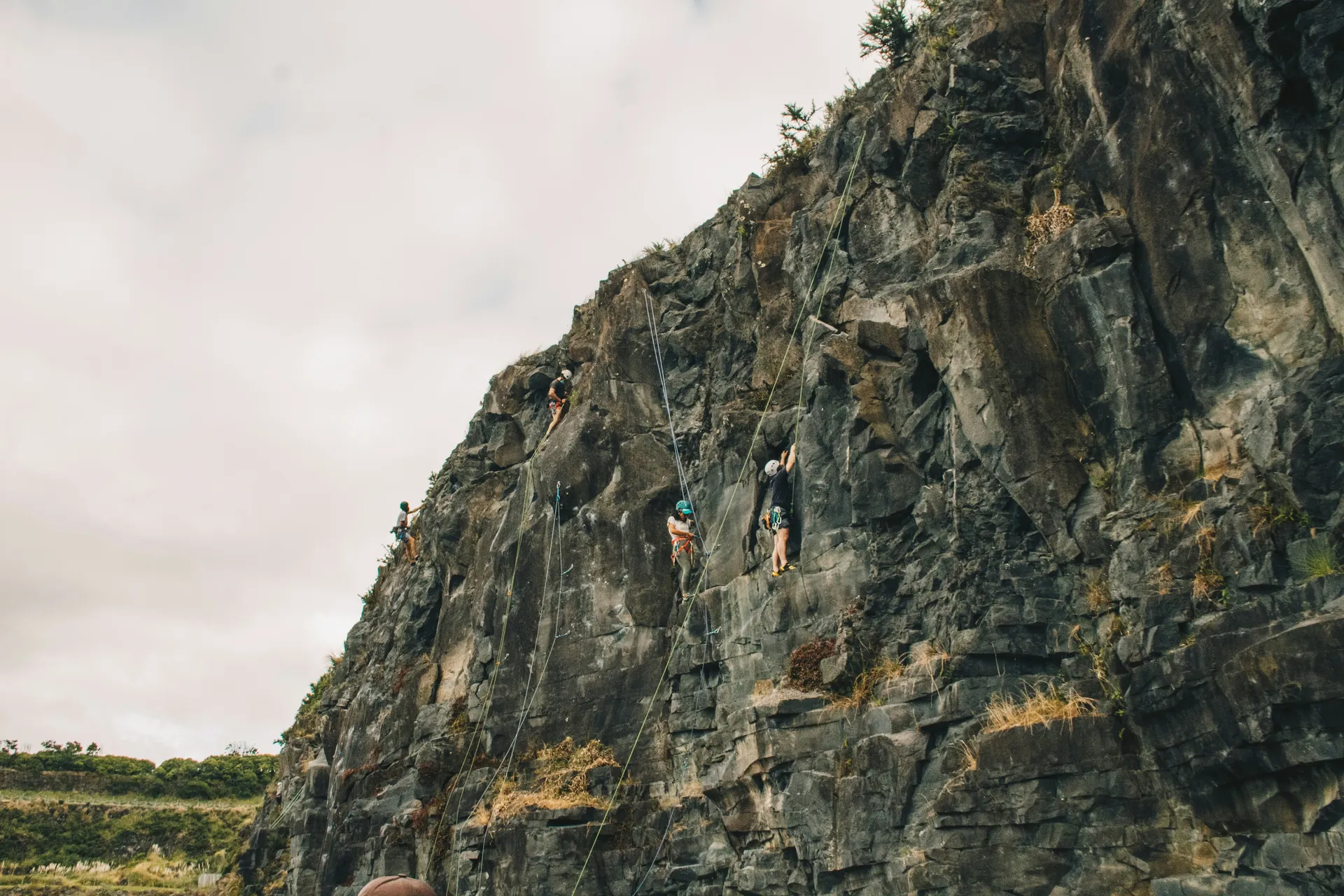
Having a clear roadmap can help you navigate your climbing journey with confidence. Many climbing courses offer structured pathways over 4 to 6 weeks, tailored to your skill level. This ensures you know what to expect and can track your progress effectively.
These level-based roadmaps break down essential milestones and skills to master, providing a realistic timeline and clear goals to discuss with your instructor.
Beginner pathway
In the beginner pathway, Week 1 introduces you to climbing basics and belay fundamentals, ensuring you understand safety protocols and rope handling. Week 2 focuses on movement drills to develop balance, footwork, and smooth climbing technique. By Week 3, you prepare for your supervised belay test, practicing knots and communication skills.
Weeks 4 through 6 are dedicated to building mileage on the wall and refining technique through targeted practice blocks, setting you up for safe and confident climbing.
Intermediate pathway
The intermediate pathway typically rotates through focused weekly themes: footwork economy to conserve energy, route-reading and pacing to tackle climbs efficiently, and redpoint tactics that involve planning sequences for successful ascents. Structured rest days are incorporated to maximize recovery and performance, allowing you to push limits while reducing injury risk.
Lead pathway (when ready)
For those ready to progress to lead climbing, the pathway begins with ground-based drills concentrating on clipping and rope management. Next, you practice mock leads on a top-rope setup to build confidence in clipping and lead belaying. Following this, you undertake your first real lead climbs under coach supervision, applying new skills in a controlled environment.
Finally, fall practice protocols are introduced progressively to safely manage the mental challenges of lead falls.
Common mistakes lessons address
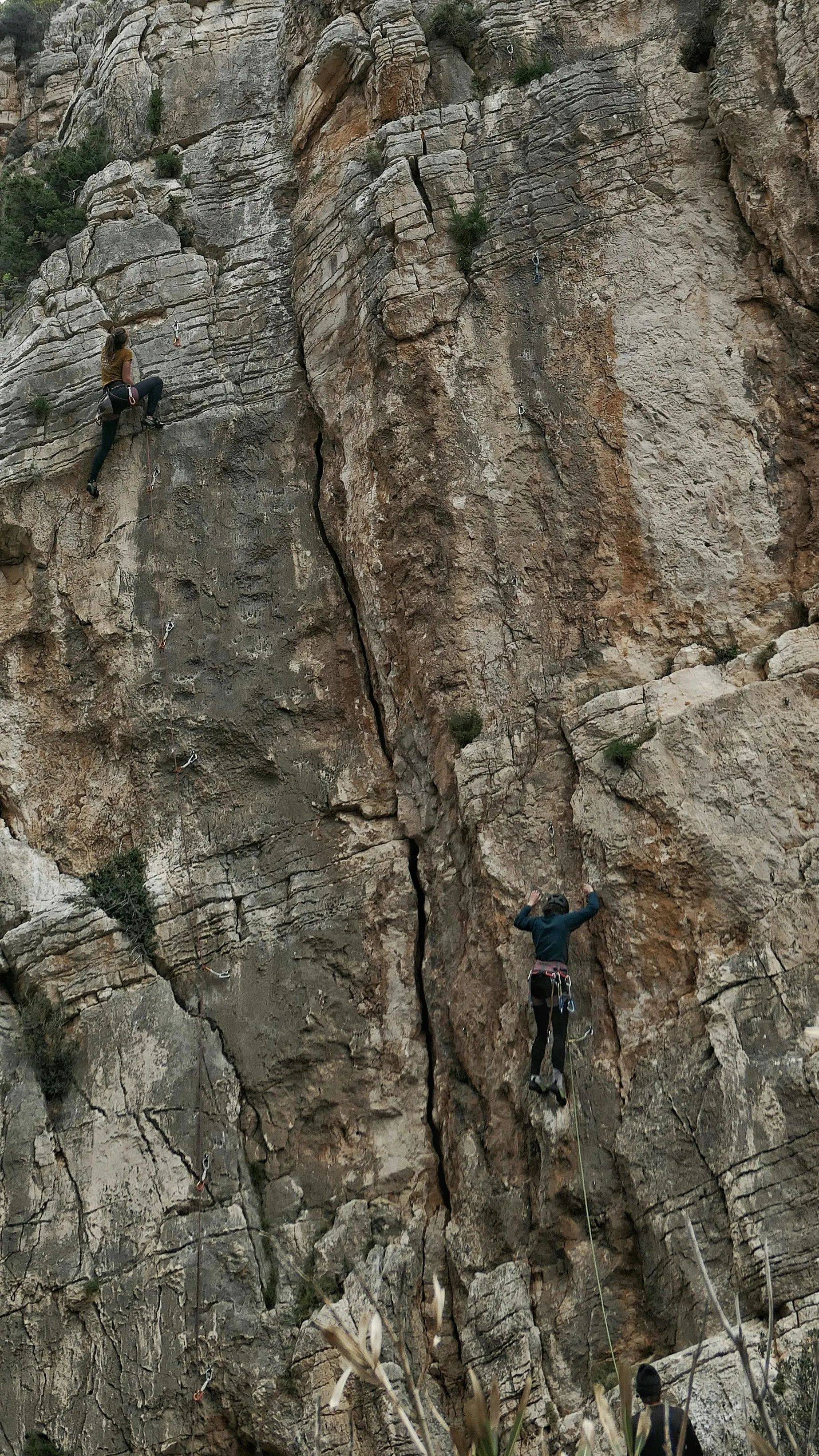
Climbing lessons are designed not only to teach you new skills but also to help you identify and correct common mistakes that can hinder your progress or compromise safety. Below are some frequent errors climbers make and how experienced instructors work to fix them.
Overgripping & tired forearms
Many climbers tend to grip holds too tightly, which quickly exhausts their forearms and leads to fatigue. The coaching fix includes practicing controlled breathing, using relaxed straight-arm rests whenever possible, deliberately choosing bigger footholds to offload the arms, and incorporating purposeful shakeouts to recover grip strength during climbs.
Noisy feet & rushed movement
Loud foot placement and hurried climbing disrupt balance and waste energy. Your instructor will introduce quiet-feet drills to help you place feet softly and precisely, keep your hips close to the wall for better body positioning, and teach you to commit your weight to footholds before pulling with your hands, making your movement smoother and more efficient.
Weak partner communication
Miscommunications can lead to accidents or inefficient climbing. Coaches emphasize the importance of using standard climbing commands clearly and consistently, performing thorough partner checks every time, and maintaining eye contact to ensure mutual understanding and safety throughout the climb.
Assessment & progression
Structured assessment is a vital part of climbing lessons, helping both you and your instructor determine when you’re ready to advance to the next level. Most programs use detailed skills checklists that cover essential proficiencies like knot tying, belay techniques, movement fundamentals, and safety protocols.
Keeping a simple logbook where you record your climbs, strengths, and areas to improve can provide clear evidence of your progress over time. It also helps tailor future lessons to focus on specific skill gaps.
In addition to initial assessments, scheduling a re-assessment within 2 to 4 weeks allows you to review your development, reinforce good habits, and ensure retention of critical skills before moving on. This repeat evaluation also provides an opportunity to address any lingering uncertainties or mistakes, solidifying your foundation for confident climbing.
Conclusion
Rock climbing lessons provide a clear and structured path for beginners, guiding you from your first attempt to becoming a confident climber. These lessons focus on building essential skills in safety, movement, and equipment handling. Whether you choose to begin indoors or dive straight into outdoor climbing, professional lessons help you avoid common mistakes and ensure steady progress with expert guidance.
When selecting a course, make sure to choose instructors with the proper qualifications. Additionally, following fitness routines and practicing technique homework will significantly accelerate your growth.
Most importantly, climbing is not just about physical abilities—it also develops problem-solving skills and mental resilience. Take that first step, enroll in a climbing course, and embark on a rewarding journey toward mastery and adventure.
FAQ
What essential gear do I need for my first rock climbing lesson to ensure safety and comfort?
For your first rock climbing lesson, the essential gear includes a well-fitting climbing harness, a certified climbing helmet, snug climbing shoes with good grip, and a belay device for rope control. Additionally, chalk and a chalk bag help keep your hands dry. These items ensure safety, comfort, and grip during your climb.
How do rock climbing lessons progress from initial skills to becoming a confident climber?
Rock climbing lessons begin with basic skills such as top roping, safety protocols, and simple movements. As you advance, you’ll learn techniques for handling various holds, improve your strength and endurance through structured training phases (power, power endurance, and endurance), and practice more complex routes. Confidence builds as you gradually tackle harder climbs and transition to lead climbing.
What are the most common beginner mistakes in rock climbing and how can I avoid them?
Common mistakes among beginners include attempting climbs that are too difficult, skipping warm-ups, neglecting proper footwork, relying on bent arms, and rushing through moves. To avoid these, climb within your skill level, warm up properly, focus on precise foot placement (using your toes), keep your arms straight to reduce fatigue, and move steadily and thoughtfully.
How is safety maintained during climbing lessons, especially for those afraid of heights or new to falling?
Safety during climbing lessons is ensured through professional instruction on the proper use of gear, belaying, and knot tying. Instructors emphasize trust, clear communication, and following established rules. Beginners are taught controlled falling techniques, how to tie in safely, and are supported with appropriate equipment and spotting. This is especially helpful for those who are afraid of heights or new to falling.

